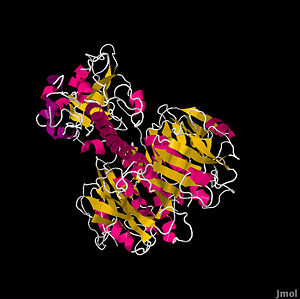User:Dan Huettner/Sandbox 2
From Proteopedia
(Difference between revisions)
| Line 3: | Line 3: | ||
===INTRODUCTION=== | ===INTRODUCTION=== | ||
[[ Image:1XTC.jpg|300px|left| | thumb| Cholera Toxin: A subunit (upper left) & B subunit (right) ]] | [[ Image:1XTC.jpg|300px|left| | thumb| Cholera Toxin: A subunit (upper left) & B subunit (right) ]] | ||
| + | The Cholera Toxin is released by the pathogen ''Vibrio cholerae'' during colonization of the small intestine. The genus ''Vibrio'' typically contains water organisms that are mainly found in salt water; however, there are few that can grow in freshwater. These organisms use glucose as their main energy and fuel source, while using flagella for locomotion. There are three different toxins from ''Vibrio cholerae'' that can result in Cholera: Cholera toxin, Zonula Occludens Toxin, and Accessory Cholera Enterotoxin. | ||
----- | ----- | ||
| - | === | + | ===STRUCTURE=== |
----- | ----- | ||
===MECHANISM=== | ===MECHANISM=== | ||
----- | ----- | ||
Revision as of 16:15, 9 April 2011
Contents |
CHOLERA TOXIN
INTRODUCTION
The Cholera Toxin is released by the pathogen Vibrio cholerae during colonization of the small intestine. The genus Vibrio typically contains water organisms that are mainly found in salt water; however, there are few that can grow in freshwater. These organisms use glucose as their main energy and fuel source, while using flagella for locomotion. There are three different toxins from Vibrio cholerae that can result in Cholera: Cholera toxin, Zonula Occludens Toxin, and Accessory Cholera Enterotoxin.

